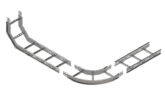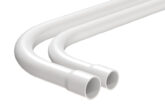
Mark Williams, Lead Marketing Manager for Cable Management at Legrand, talks through some simple tips you should adopt during specification of cable management systems.
Location
Consider what elements the cable management system will be exposed to. If the system is to be located in a corrosive environment or a marine location, for example, the requirements will be very different to that of an internal commercial building installation. Legrand’s industry experts and cable management technical product guides can offer in-depth advice on what to consider when selecting your material.
Consider the cable used
It’s important to consider what type of cable will be used throughout the installation and if support/protection is needed. Single insulated (non-sheathed) cables require additional mechanical protection (as per BS 7671), as well as support, and therefore an IP4X or IPXXD distribution trunking system is generally the solution of choice as it fully encases the cables. If using armoured cables, an open cable management system, such as steel wire cable tray, perforated tray or cable ladder, is considered more suitable.
Weight
Calculate the total weight to be supported by the cable management system, taking into consideration current requirements and potential needs in the future. Remember that the total loading should be calculated based on not only the weight of the cables, but also any ancillary items that are subsequently fitted to the cable management system, such as light fittings, and also external forces such as weather and the surrounding environment.
Regulations and Standards
Wiring regulations can differ depending on the installation or location of the project you’re working on, so it’s imperative to monitor and review the guidelines, prior to an installation. Amendments to BS 7671, for example, have to be monitored and respected. This can influence the selection of cable management systems as you may need to opt for a solution that ensures avoidance of premature collapse of the cabling system. In this instance, metallic solutions may be the preferred option.
Scalability
It can be tempting to build in redundant capacity during the design and specification stages of a project rather than designing a system that can be easily adapted in the future. Planning ahead has the potential to save businesses time and money in the longer term, so it’s worth considering in the design stages. Remember, when considering scalability, retrofitting can be expensive and not all systems can be easily integrated with one another. Consider this at the design stage by specifying a system that can easily interface with others.
Range of accessories
Take the time to specify a system that offers a full range of accessories including brackets, fixings and couplers, from one source. Work with your supplier to ensure you specify the correct amount of fittings, brackets and fixings in order to prevent delays on site.
Effective cable management can help to enhance cable performance, longevity and future flexibility in terms of business growth, if implemented effectively. There isn’t a “one solution fits all”, so it’s vitally important that the correct system is chosen from the outset. By selecting a cable management system that excels in each of these areas, you will not only have a system that reduces installation time, but also one that can meet your needs today and tomorrow.
For more information on Legrand’s cable management solutions, visit: https://www.legrand.co.uk/








